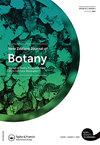推断新西兰唯一的地方性全寄生植物——濒临灭绝的羊蹄草的生物地理特征
IF 1.4
4区 生物学
Q4 PLANT SCIENCES
引用次数: 2
摘要
摘要尽管有着丰富的植物学研究历史,但对新西兰植物物种的遗传变异分布却知之甚少。原生维管植物群由~80%的特有种组成,其中近一半受到威胁,迫切需要更好地了解单个植物物种的种内多样性和更广泛的新西兰植物群的生物地理模式。为此,我们研究了当地根全寄生虫Dactylanthus taylori(pua o te Rıinga,Mystropetalaceae)的种群遗传结构。对来自新西兰北岛31个地点(Te Ika-A-Māui,Aotearoa)的235名个体进行了一系列核微卫星基因座的基因分型。在个体和种群水平上分析了基因型数据,以评估种群内部和种群之间的遗传多样性,并调查物种内遗传变异的地理分布。使用贝叶斯聚类、主成分判别分析和邻居网络分析来评估群体结构。揭示了遗传多样性的等级模式,有证据表明存在三个广泛的地理区域群(西部、东部和中部火山高原(CVP))。经过进一步分析,三个地理群中的每一个都进一步按层次细分为两个或三个遗传亚群。研究发现,这种濒危物种的遗传多样性相对较高,但在不同种群中差异很大。遗传群的分布似乎受到了过去火山活动的影响,因为CVP群与1.8 kaTaupō火山喷发以及西部和东部火山群可能由于中央火山带反复发生的火山活动而出现分歧。这里解析的遗传结构为泰洛氏D.taylori的具体管理和我们对新西兰生物地理学的总体理解提供了重要信息。本文章由计算机程序翻译,如有差异,请以英文原文为准。
Inferring the biogeography of New Zealand’s only endemic holoparasitic plant, the threatened Dactylanthus taylorii (Mystropetalaceae)
ABSTRACT Despite a rich history of botanical research, little is known about the distribution of genetic variation within New Zealand plant species. With a native vascular flora that consists of ∼80% endemics, nearly one-half of which are threatened, there is a dire need for a better understanding of intraspecific diversity for individual plant species and of biogeographic patterns for the wider New Zealand flora. To these ends, we have investigated population genetic structure in the endemic root holoparasite, Dactylanthus taylorii (pua o te Rēinga, Mystropetalaceae). A total of 235 individuals from 31 locations across the North Island of New Zealand (Te Ika-a-Māui, Aotearoa) were genotyped for a suite of nuclear microsatellite loci. Genotype data were analysed at the individual and population levels to assess genetic diversity within and among populations and to investigate the geographic distribution of genetic variation within the species. Population structure was assessed using Bayesian clustering, discriminant analysis of principal components, and a Neighbor-Net analysis. A hierarchical pattern of genetic diversity was revealed, with evidence for three broad geographic regional groupings (West, East, and Central Volcanic Plateau (CVP)). Upon further analysis, each of the three geographic groups further subdivide hierarchically into two or three genetic subgroups. Genetic diversity was found to be relatively high in this endangered species but varies considerably across populations. The distribution of genetic groups appears to have been influenced by past volcanic activity as the CVP group is largely coincident with a distinct tephra isopach from the 1.8 ka Taupō eruption and the West and East groups may have diverged due to recurring volcanic activity in the Central Volcanic Zone. The genetic structure resolved here provides important information for the management of D. taylorii specifically and for our understanding of New Zealand biogeography generally.
求助全文
通过发布文献求助,成功后即可免费获取论文全文。
去求助
来源期刊

New Zealand Journal of Botany
生物-植物科学
CiteScore
2.20
自引率
22.20%
发文量
27
审稿时长
>12 weeks
期刊介绍:
The New Zealand Journal of Botany publishes original research papers, review papers, perspectives, short communications, forum articles, letter and book reviews. We welcome submissions relevant to all aspects of the botany, mycology, and phycology of the South Pacific, Australia, South America, and Southern Africa. The journal’s subject matter encompasses biosystematics and biogeography, ecology, physiology, biochemistry, genetics, reproductive biology, structure and development, taxonomy, ethnobotany, palaeobotany, bryology, lichenology, mycology, plant pathology, and phycology.
 求助内容:
求助内容: 应助结果提醒方式:
应助结果提醒方式:


